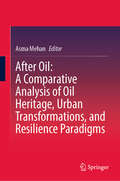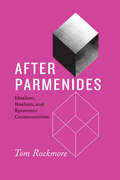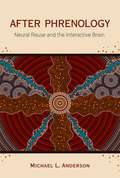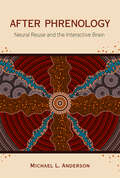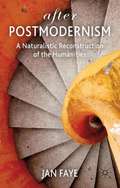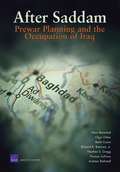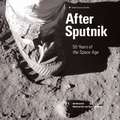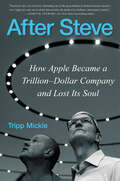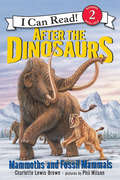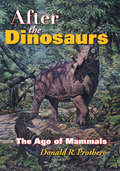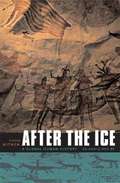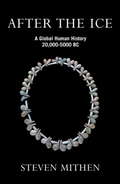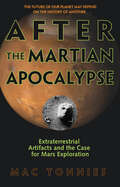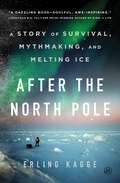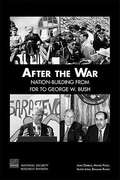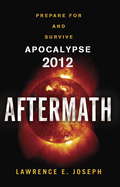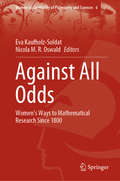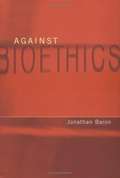- Table View
- List View
After Oil : A Comparative Analysis of Oil Heritage, Urban Transformations, and Resilience Paradigms
by Asma MehanThis book offers an academic analysis of the concept of heritage within the realm of oil-related urban development. It focuses on the term 'heritage', with a specific emphasis on 'oil heritage', exploring its varied implications for urban futures. The book provides a nuanced understanding of heritage, discussing its different interpretations and values across cultural and environmental contexts. It examines the legacy of oil, assessing its role and impact on societies. It presents a balanced view, acknowledging both the economic benefits of oil in urban growth and the environmental and socio-economic issues it poses. This approach places oil heritage within a broader heritage context, critically evaluating its unique characteristics. The book also investigates how various cultures perceive and engage with the idea of oil heritage. It highlights the contrast between the political debates over oil in Western countries and the developmental challenges faced by emerging economies, showcasing the global variance in the concept of 'oil heritage'. Additionally, the narrative considers the changing role and meaning of oil over time, reflecting on its historical importance and the challenges it poses for the future, especially in transitioning to a post-oil era. Through its chapters, the book provides a critical examination of the interplay between oil, urban development, and heritage studies. It is designed to contribute to scholarly discourse in these areas, targeting academics, students, policymakers, and professionals interested in the intricate relationship between oil heritage and urban dynamics.
After Parmenides: Idealism, Realism, and Epistemic Constructivism
by Tom RockmoreEngages with one of the oldest philosophical problems—the relationship between thought and being—and offers a fresh perspective with which to approach the long history of this puzzle. In After Parmenides, Tom Rockmore takes us all the way back to the beginning of Western philosophy, when Parmenides asserted that thought and being are the same. This idea created a division between what the mind constructs as knowable entities and the idea that there is also a mind-independent real, which we can know or fail to know. Rockmore argues that we need to give up on the idea of knowing the real as it is, and instead focus on the objects of cognition that our mind constructs. Though we cannot know mind-independent objects as they “really” are, we can and do know objects as they appear to us.After Parmenides charts the continual engagement with these ideas of the real and the knowable throughout philosophical history from Plato and Aristotle to Descartes, Kant, Fichte, Hegel, Schopenhauer, Marx, and others. This ambitious book shows how new connections can be made in the history of philosophy when it is reread through a new lens.
After Phrenology
by Michael L. AndersonThe computer analogy of the mind has been as widely adopted in contemporary cognitive neuroscience as was the analogy of the brain as a collection of organs in phrenology. Just as the phrenologist would insist that each organ must have its particular function, so contemporary cognitive neuroscience is committed to the notion that each brain region must have its fundamental computation. In After Phrenology, Michael Anderson argues that to achieve a fully post-phrenological science of the brain, we need to reassess this commitment and devise an alternate, neuroscientifically grounded taxonomy of mental function. Anderson contends that the cognitive roles played by each region of the brain are highly various, reflecting different neural partnerships established under different circumstances. He proposes quantifying the functional properties of neural assemblies in terms of their dispositional tendencies rather than their computational or information-processing operations. Exploring larger-scale issues, and drawing on evidence from embodied cognition, Anderson develops a picture of thinking rooted in the exploitation and extension of our early-evolving capacity for iterated interaction with the world. He argues that the multidimensional approach to the brain he describes offers a much better fit for these findings, and a more promising road toward a unified science of minded organisms.
After Phrenology: Neural Reuse and the Interactive Brain
by Michael L. AndersonA proposal for a fully post-phrenological neuroscience that details the evolutionary roots of functional diversity in brain regions and networks.The computer analogy of the mind has been as widely adopted in contemporary cognitive neuroscience as was the analogy of the brain as a collection of organs in phrenology. Just as the phrenologist would insist that each organ must have its particular function, so contemporary cognitive neuroscience is committed to the notion that each brain region must have its fundamental computation. In After Phrenology, Michael Anderson argues that to achieve a fully post-phrenological science of the brain, we need to reassess this commitment and devise an alternate, neuroscientifically grounded taxonomy of mental function. Anderson contends that the cognitive roles played by each region of the brain are highly various, reflecting different neural partnerships established under different circumstances. He proposes quantifying the functional properties of neural assemblies in terms of their dispositional tendencies rather than their computational or information-processing operations. Exploring larger-scale issues, and drawing on evidence from embodied cognition, Anderson develops a picture of thinking rooted in the exploitation and extension of our early-evolving capacity for iterated interaction with the world. He argues that the multidimensional approach to the brain he describes offers a much better fit for these findings, and a more promising road toward a unified science of minded organisms.
After Physics
by David Z. AlbertHere the philosopher and physicist David Z Albert argues, among other things, that the difference between past and future can be understood as a mechanical phenomenon of nature and that quantum mechanics makes it impossible to present the entirety of what can be said about the world as a narrative of "befores" and "afters."
After Postmodernism
by Jan FayeThe philosophy of the humanistic sciences has been a blind-spot in analytic philosophy. This book argues that by adopting an appropriate pragmatic analysis of explanation and interpretation it is possible to show that scientific practice of humanistic sciences can be understood on similar lines to scientific practice of natural and social sciences.
After Saddam: Prewar Planning and the Occupation of Iraq
by Nora Bensahel Olga Oliker Keith Crane Heather S. Gregg Richard R. BrennanThis monograph examines prewar planning efforts for the reconstruction of postwar Iraq. It then examines the role of U.S. military forces after major combat officially ended on May 1, 2003, through June 2004. Finally, it examines civilian efforts at reconstruction, focusing on the activities of the Coalition Provisional Authority and its efforts to rebuild structures of governance, security forces, economic policy, and essential services.
After Sputnik
by Martin CollinsIn the 50 years since Sputnik's historic orbit kickstarted a race to the stars, spaceflight has moved from a speculative and experimental science to a staple of contemporary life. Space exploration has changed the way we look at our universe, our planet, and even the people around us. AFTER SPUTNIK will explore the first 50 years of achievements in space with a guided tour of the artifacts in the collection of the National Air and Space Museum. This is the premier collection of space artifacts in the world, and includes most US artifacts; major Russian artifacts on loan; and most recently, Burt Rutan's Space Ship One. In addition, the museum's popular culture collection and an art collection include objects such as a 1930s Buck Rogers stopwatch, and Norman Rockwell's famous painting, Suiting Up. Using a selection of 180 to 200 objects, this book will tell the artifact stories to convey a sense of what it was like to be there when the object was in use, accompanied by dramatic photographs. The artifacts will range from the famous, such as John Glenn's Friendship 7 Mercury spacecraft and the Mars Pathfinder lander and Sojourner rover, to the equally rare, but less well-known, such as the Surveyor 3 camera returned from the Moon and Gordon Cooper's space boots. No other book can offer this breadth and depth of artifacts.
After Steve: How Apple Became a Trillion-Dollar Company and Lost Its Soul
by Tripp MickleFrom the Wall Street Journal’s Tripp Mickle, the dramatic, untold story inside Apple after the passing of Steve Jobs by following his top lieutenants—Jony Ive, the Chief Design Officer, and Tim Cook, the COO-turned-CEO—and how the fading of the former and the rise of the latter led to Apple losing its soul.Steve Jobs called Jony Ive his “spiritual partner at Apple.” The London-born genius was the second-most powerful person at Apple and the creative force who most embodies Jobs’s spirit, the man who designed the products adopted by hundreds of millions the world over: the iPod, iPad, MacBook Air, the iMac G3, and the iPhone. In the wake of his close collaborator’s death, the chief designer wrestled with grief and initially threw himself into his work designing the new Apple headquarters and the Watch before losing his motivation in a company increasingly devoted more to margins than to inspiration.In many ways, Cook was Ive’s opposite. The product of a small Alabama town, he had risen through the ranks from the supply side of the company. His gift was not the creation of new products. Instead, he had invented countless ways to maximize a margin, squeezing some suppliers, persuading others to build factories the size of cities to churn out more units. He considered inventory evil. He knew how to make subordinates sweat with withering questions.Jobs selected Cook as his successor, and Cook oversaw a period of tremendous revenue growth that has lifted Apple’s valuation to $2 trillion. He built a commanding business in China and rapidly distinguished himself as a master politician who could forge global alliances and send the world’s stock market into freefall with a single sentence.Author Tripp Mickle spoke with more than 200 current and former Apple executives, as well as figures key to this period of Apple’s history, including Trump administration officials and fashion luminaries such as Anna Wintour while writing After Steve. His research shows the company’s success came at a cost. Apple lost its innovative spirit and has not designed a new category of device in years. Ive’s departure in 2019 marked a culmination in Apple’s shift from a company of innovation to one of operational excellence, and the price is a company that has lost its soul.
After This
by Claire Bidwell SmithIn After This, acclaimed author, and therapist Claire Bidwell Smith confronts the question she encounters every day in private practice--what happens after we die? In an exploration of the afterlife that is part personal, part prescriptive--Smith invites us on her journey into the unknown. She wonders: How do we grieve our loved ones without proof that they live on? Will we ever see them again? Can they see us now, even though they are gone?Chronicling our steps along the path that bridges this world and the next, Smith undergoes past-life regressions and sessions with mediums and psychics and immerses herself in the ceremonies of organized religion and the rigor of scientific experiments to try and find the answers. Drawing on both her personal losses, recounted in her memoir The Rules of Inheritance, as well as her background working in hospice as a bereavement counselor, Smith attempts to show how exploring the afterlife can have a positive impact on the grief process. personal journey that underlies the book's message: What we believe about what happens next affects everything about how we live--and love--right now.
After the Dinosaurs: Mammoths and Fossil Mammals (I Can Read Level 2)
by Charlotte Lewis BrownAfter the age of the dinosaurs, strange and powerful mammals ruled the earth. . . . Paleontologist Charlotte Lewis Brown’s easy-to-read and fascinating descriptions of these ancient animals are brought to life in Phil Wilson’s detailed illustrations. Read about the largest mammal ever to walk on land, about a tiger with teeth longer than your hand, and about a horse the size of a dog! Mammals—some strange and some strangely familiar—ruled the earth after the dinosaurs. These compelling creatures are introduced to beginning readers by the team who created The Day the Dinosaurs Died. After the Dinosaurs is a Level Two I Can Read, geared for kids who read on their own but still need a little help. Whether shared at home or in a classroom, the engaging stories, longer sentences, and language play of Level Two books are proven to help kids take their next steps toward reading success.
After the Dinosaurs: The Age of Mammals (Life Of The Past Ser.)
by Donald R. ProtheroA fascinating study of the thousands of new animal species that walked in the footsteps of the dinosaurs—and the climate changes that brought them forth. The fascinating group of animals called dinosaurs became extinct some 65 million years ago (except for their feathered descendants). In their place evolved an enormous variety of land creatures, especially mammals, which in their way were every bit as remarkable as their Mesozoic cousins. The Age of Mammals, the Cenozoic Era, has never had its Jurassic Park, but it was an amazing time in earth&’s history, populated by a wonderful assortment of bizarre animals. The rapid evolution of thousands of species of mammals brought forth many incredible creatures―including our own ancestors. Their story is part of a larger story of new life emerging from the greenhouse conditions of the Mesozoic, warming up dramatically about 55 million years ago, and then cooling rapidly so that 33 million years ago the glacial ice returned. The earth&’s vegetation went through equally dramatic changes, from tropical jungles in Montana and forests at the poles. Life in the sea underwent striking evolution reflecting global climate change, including the emergence of such creatures as giant sharks, seals, sea lions, dolphins, and whales. Engaging and insightful, After the Dinosaurs is a book for everyone who has an abiding fascination with the remarkable life of the past.
After the Flood: Imagining the Global Environment in Early Modern Europe
by Lydia BarnettHow the story of Noah's Flood was central to the development of a global environmental consciousness in early modern Europe.Winner of the Morris D. Forkosch Prize by the Journal of the History of Ideas, Short-listed for the Kenshur Prize by the Center for Eighteenth-Century Studies, Indiana UniversityMany centuries before the emergence of the scientific consensus on climate change, people began to imagine the existence of a global environment: a natural system capable of changing humans and of being changed by them. In After the Flood, Lydia Barnett traces the history of this idea back to the early modern period, when the Scientific Revolution, the Reformations, the Little Ice Age, and the overseas expansion of European empire, religion, and commerce gave rise to new ideas about nature and humanity, and their intersecting histories. Recovering a forgotten episode in the history of environmental thought, Barnett brings to light the crucial role of religious faith and conflict in fostering new ways of thinking about the capacity of humans and nature to change each other on a planetary scale. In the hands of Protestant and Catholic writers from across Europe and its American colonies, the biblical story of Noah's Flood became a vehicle for imagining the power of sin to wreck the world, the dangers of overpopulation, the transformative effects of shifting landforms on the course of human history, and the impact of a changing climate on human bodies, health, and lives. Following Noah's Flood as a popular topic of debate through long-distance networks of knowledge from the late sixteenth through the early eighteenth centuries, Barnett reveals how early modern earth and environmental sciences were shaped by gender, evangelism, empire, race, and nation. After the Flood illuminates the hidden role and complicated legacy of religion in the emergence of a global environmental consciousness.
After the Ice Age: The Return of Life to Glaciated North America
by E. C. PielouThe fascinating story of how a harsh terrain that resembled modern Antarctica has been transformed gradually into the forests, grasslands, and wetlands we know today. "One of the best scientific books published in the last ten years. "-Ottowa Journal "A valuable new synthesis of facts and ideas about climate, geography, and life during the past 20,000 years. More important, the book conveys an intimate appreciation of the rich variety of nature through time. "-S. David Webb,Science
After the Ice Age: The Return of Life to Glaciated North America (None Ser.)
by E.C. PielouThe fascinating story of how a harsh terrain that resembled modern Antarctica has been transformed gradually into the forests, grasslands, and wetlands we know today.
After the Ice: A Global Human History 20,000-5000 BC
by Steven MithenArchaeology says present day humans have been on the planet for eighty thousand years. The first writing has been dated to 3,500 BC. This is what humanity may have been during from 20,000 to 5,000 BC, during the period of global warming which followed the last great ice age. The author uses archaeology to talk about humans at various times during this period of time and at various places on the planet. This book is about what life may have been like day to day over a fifteen thousand year period before we learned to write and live in cities.
After the Ice: A Global Human History, 20,000 - 5000 BC
by Prof Steven MithenA fantastic voyage through 15,000 years of history that laid the foundations for civilisation as we know it by award-winning science writer Steven Mithen.Twenty thousand years ago Earth was in the midst of an ice age. Then global warming arrived, leading to massive floods, the spread of forests and the retreat of the deserts. By 5,000 BC a radically different human world had appeared. In place of hunters and gatherers there were farmers; in place of transient campsites there were towns. The foundations of our modern world had been laid and nothing that came after - the Industrial Revolution, the atomic age, the internet - have ever matched the significance of those events. AFTER THE ICE tells the story of climate change's impact during this momentous period - one that also saw the colonisation of the Americas and mass extinctions of animals throughout the world. Drawing on the latest cutting-edge research in archaeology, cognitive science, palaeontology, geology and the evolutionary sciences, Steven Mithen creates an evocative, original and remarkably complete picture of minds, cultures, lives and landscapes through 15,000 years of history.
After the Ice: A Global Human History, 20,000 - 5000 BC
by Steven MithenA fantastic voyage through 15,000 years of history that laid the foundations for civilisation as we know it by award-winning science writer Steven Mithen.Twenty thousand years ago Earth was in the midst of an ice age. Then global warming arrived, leading to massive floods, the spread of forests and the retreat of the deserts. By 5,000 BC a radically different human world had appeared. In place of hunters and gatherers there were farmers; in place of transient campsites there were towns. The foundations of our modern world had been laid and nothing that came after - the Industrial Revolution, the atomic age, the internet - have ever matched the significance of those events. AFTER THE ICE tells the story of climate change's impact during this momentous period - one that also saw the colonisation of the Americas and mass extinctions of animals throughout the world. Drawing on the latest cutting-edge research in archaeology, cognitive science, palaeontology, geology and the evolutionary sciences, Steven Mithen creates an evocative, original and remarkably complete picture of minds, cultures, lives and landscapes through 15,000 years of history.
After the Ice: Life, Death, and Geopolitics in the New Arctic
by Alun AndersonNew from Smithsonian Books, After the Ice is an eye-opening look at the winners and losers in the high-stakes story of Arctic transformation, from nations to native peoples to animals and the very landscape itself. Author Alun Anderson explores the effects of global warming amid new geopolitical rivalries, combining science, business, politics, and adventure to provide a fascinating narrative portrait of this rapidly changing land of unparalleled global significance.
After the Martian Apocalypse: Extraterrestrial Artifacts and the Case for Mars Exploration
by Mac TonniesPart exo-archaeological treatise and part cultural commentary, After The Martian Apocalypse is an uncompromising and groundbreaking perspective on a cosmic controversy that has perplexed scientists and astronomers for years. Here, Mac Tonnies details the latest Mars discoveries and their paradigm-toppling implications, offering strong new evidence that points to an extinct civilization on the Red Planet -- and explaining how our own survival may depend on confronting the strange and ancient truths to be found there. Facing the prospect of a previous intelligent extraterrestrial civilization, Tonnies portrays Mars as a scientific and cultural conundrum. He challenges orthodox notions of mankind's role in space -- and illuminates the imperative concept that to truly understand our own world, we must first understand our unsettling and enigmatic planetary neighbor.
After the North Pole: A Story of Survival, Mythmaking, and Melting Ice
by Erling KaggeThe Norwegian explorer, philosopher and acclaimed writer tells of his historic 58-day journey to the North Pole on skis in this provocative memoir that is a profound meditation on nature and the history of explorers' obsession. The North Pole looms large in our collective psyche—the ultimate Otherland in a world mapped and traversed. It is the center of our planet’s rotation, one of the places that is most vulnerable in an epoch of global climate change. Its sub-zero temperatures and strange year of one sunset and one sunrise make it an eerie, utterly disorienting place that challenges human endurance and understanding.Erling Kagge and his friend Børge Ousland became the first people “to ever reach the pole without dogs, without depots and without motorized aids,” skiing for 58 days from a drop off point on the ice edge of Canada’s northernmost island.Erling describes his record-making journey, probing the physical challenges and psychological motivations for embarking on such an epic expedition, the history of the territory’s exploration, its place in legend and art, and the thrilling adventures he experienced during the trek. It is another example of what bestselling author Robert MacFarlane has called “Kagge’s extraordinary life in wild places,”Erling also observes the key role that this place holds in our current climate and geopolitical conversations. As majestic, mesmerizing, and monumental as the terrain it captures, After the North Pole is for anyone who has gazed out at the horizon—and wondered what happens if you keep going.After the North Pole is illustrated with 12-14 photographs.Translated from the Norwegian by Kari Dickson.
After the War: Nation-building from FDR to George W. Bush
by James Dobbins Austin Long Michele A. Poole Benjamin RunkleFrom the post-World War II era through the Cold War, post-Cold War era, and current war on terrorism, this volume assesses how U.S. presidential decisionmaking style and administrative structure can work in favor of, as well as against, the nation-building goals of the U.S. government and military and those of its coalition partners and allies.
Aftermath: A Guide to Preparing for and Surviving Apocalypse 2012
by Lawrence E. JosephWhat can we do to mitigate the coming cataclysm? Here Joseph presents the latest findings about the threats to our life on earth including an all-out collapse of power grids and satellite systems resulting from solar flares expected to climax with unprecedented ferocity in 2012. Incipient plagues, famines, droughts and runaway global warming are also assessed for their catastrophic potential. When it comes to formulating a response to an impending apocalypse, the field of options is narrow, but Joseph argues that there is plenty of constructive action that can be taken at the personal, local, national, and global level, individually and collectively, to prepare for, endure and emerge from disaster.
Against All Odds: Women’s Ways to Mathematical Research Since 1800 (Women in the History of Philosophy and Sciences #6)
by Eva Kaufholz-Soldat Nicola M. R. OswaldThis book presents an overview of the ways in which women have been able to conduct mathematical research since the 18th century, despite their general exclusion from the sciences. Grouped into four thematic sections, the authors concentrate on well-known figures like Sophie Germain and Grace Chisholm Young, as well as those who have remained unnoticed by historians so far. Among them are Stanisława Nidodym, the first female students at the universities in Prague at the turn of the 20th century, and the first female professors of mathematics in Denmark. Highlighting individual biographies, couples in science, the situation at specific European universities, and sociological factors influencing specific careers from the 18th century to the present, the authors trace female mathematicians’ status as it evolved from singular and anomalous to virtually commonplace.The book also offers insights into the various obstacles women faced when trying to enter perhaps the “most male” discipline of all, and how some of them continue to shape young girls’ self-perceptions and career choices today. Thus, it will benefit scholars and students in STEM disciplines, gender studies and the history of science; women in science, mathematics and at institutions, and those working in mathematics education.
Against Bioethics
by Jonathan BaronGovernments, health professionals, patients, research institutions, and research subjects look to bioethicists for guidance in making important decisions about medical treatment and research.
